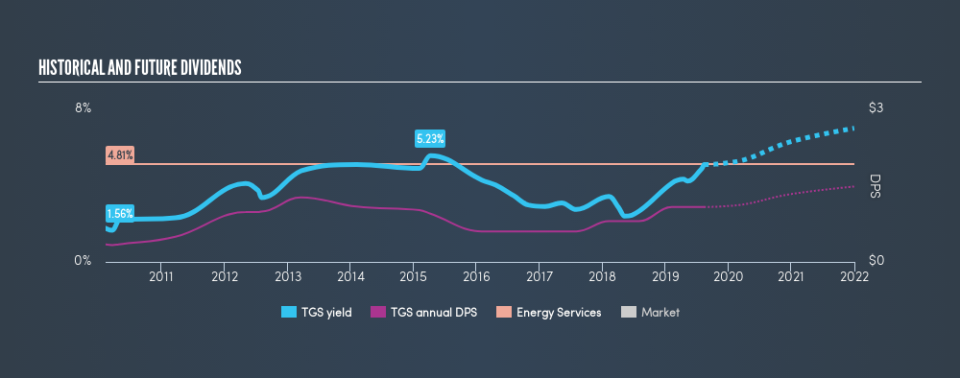Should You Buy TGS-NOPEC Geophysical Company ASA (OB:TGS) For Its 4.8% Dividend?

Today we'll take a closer look at TGS-NOPEC Geophysical Company ASA (OB:TGS) from a dividend investor's perspective. Owning a strong business and reinvesting the dividends is widely seen as an attractive way of growing your wealth. If you are hoping to live on the income from dividends, it's important to be a lot more stringent with your investments than the average punter.
With TGS-NOPEC Geophysical yielding 4.8% and having paid a dividend for over 10 years, many investors likely find the company quite interesting. It would not be a surprise to discover that many investors buy it for the dividends. The company also bought back stock equivalent to around 0.7% of market capitalisation this year. Some simple analysis can offer a lot of insights when buying a company for its dividend, and we'll go through this below.
Explore this interactive chart for our latest analysis on TGS-NOPEC Geophysical!
Payout ratios
Dividends are typically paid from company earnings. If a company pays more in dividends than it earned, then the dividend might become unsustainable - hardly an ideal situation. So we need to form a view on if a company's dividend is sustainable, relative to its net profit after tax. Looking at the data, we can see that 66% of TGS-NOPEC Geophysical's profits were paid out as dividends in the last 12 months. This is a fairly normal payout ratio among most businesses. It allows a higher dividend to be paid to shareholders, but does limit the capital retained in the business - which could be good or bad.
In addition to comparing dividends against profits, we should inspect whether the company generated enough cash to pay its dividend. TGS-NOPEC Geophysical paid out 76% of its cash flow last year. This may be sustainable but it does not leave much of a buffer for unexpected circumstances. It's positive to see that TGS-NOPEC Geophysical's dividend is covered by both profits and cash flow, since this is generally a sign that the dividend is sustainable, and a lower payout ratio usually suggests a greater margin of safety before the dividend gets cut.
We update our data on TGS-NOPEC Geophysical every 24 hours, so you can always get our latest analysis of its financial health, here.
Dividend Volatility
From the perspective of an income investor who wants to earn dividends for many years, there is not much point buying a stock if its dividend is regularly cut or is not reliable. For the purpose of this article, we only scrutinise the last decade of TGS-NOPEC Geophysical's dividend payments. The dividend has been cut by more than 20% on at least one occasion historically. During the past ten-year period, the first annual payment was US$0.35 in 2009, compared to US$1.08 last year. This works out to be a compound annual growth rate (CAGR) of approximately 12% a year over that time. TGS-NOPEC Geophysical's dividend payments have fluctuated, so it hasn't grown 12% every year, but the CAGR is a useful rule of thumb for approximating the historical growth.
So, its dividends have grown at a rapid rate over this time, but payments have been cut in the past. The stock may still be worth considering as part of a diversified dividend portfolio.
Dividend Growth Potential
With a relatively unstable dividend, it's even more important to evaluate if earnings per share (EPS) are growing - it's not worth taking the risk on a dividend getting cut, unless you might be rewarded with larger dividends in future. TGS-NOPEC Geophysical's earnings per share have shrunk at 12% a year over the past five years. With this kind of significant decline, we always wonder what has changed in the business. Dividends are about stability, and TGS-NOPEC Geophysical's earnings per share, which support the dividend, have been anything but stable.
Conclusion
Dividend investors should always want to know if a) a company's dividends are affordable, b) if there is a track record of consistent payments, and c) if the dividend is capable of growing. First, we think TGS-NOPEC Geophysical is paying out an acceptable percentage of its cashflow and profit. Unfortunately, the company has not been able to generate earnings per share growth, and cut its dividend at least once in the past. In summary, TGS-NOPEC Geophysical has a number of shortcomings that we'd find it hard to get past. Things could change, but we think there are a number of better ideas out there.
Without at least some growth in earnings per share over time, the dividend will eventually come under pressure either from costs or inflation. See if the 9 analysts are forecasting a turnaround in our free collection of analyst estimates here.
We have also put together a list of global stocks with a market capitalisation above $1bn and yielding more 3%.
We aim to bring you long-term focused research analysis driven by fundamental data. Note that our analysis may not factor in the latest price-sensitive company announcements or qualitative material.
If you spot an error that warrants correction, please contact the editor at editorial-team@simplywallst.com. This article by Simply Wall St is general in nature. It does not constitute a recommendation to buy or sell any stock, and does not take account of your objectives, or your financial situation. Simply Wall St has no position in the stocks mentioned. Thank you for reading.

 Yahoo Finance
Yahoo Finance 
